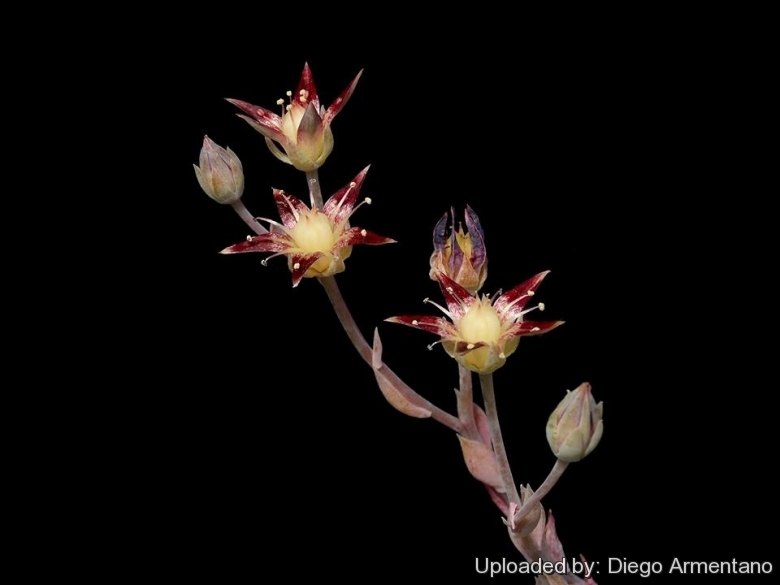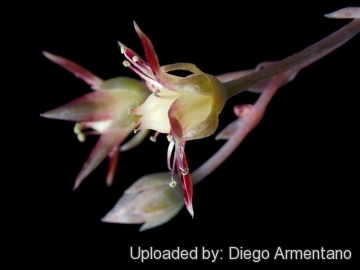




Your support is critical to our success.

Origin and Habitat: Graptopetalum macdougallii is native to the mountains west of Tehuantepec (San Mifuel Tenango, Santo Domingo, Las Cruces), Oaxaca, Mexico. It is geographically isolated from all other Graptopetalum species.
Altitude range: 1150 - 2100 metres abpve sea level.
Habitat and ecology: This species lives in temperate climates on somewhat shady rocks where it forms large mats, or rarely as an epiphytic. This is an endemic species of restricted distribution, threatened by land use change due to agriculture and urbanization. Populations are strongly impacted by collections of plants used as a decoration for Christmas holidays in the town of Tehuantepec and its surroundings.
Synonyms:
- Graptopetalum macdougallii Alexander
Description: Graptopetalum macdougalliiSN|32680]]SN|32680]] is a caulescent, succulent plant with its leaves arranged in rosettes. It may form stout clumps up to1 m in spread by means of short stolons and axillary basal shoots or stems. It has a shimmering blue-white colouring that gives it a delicate beauty. A protective waxy powder that covers the succulent leaves provides this colouration. The flowers are c. 2.5 cm across, each with 5 petals marked with dense red lines. This species is most attractive.
Derivation of specific name: This member of the Cactaceae family was given this name by US botanist Thomas (Tom) MacDougall who collected this plant in January 1938 in Oaxaca, and named after him. Tom Macdougall spent the last half of his life searching for plants in Mexico.
Rosettes: Each ground-hugging rosette bears up to 50 leaves and is about 2-7 cm in diameter. The leaves spreading during the growth season, are brought close together during the dry season, arched inward so that the points meet at the centre of the rosette.
Leaves: Each leaf is 25-35 mm long, 8-15 mm wide, rounded, tongue-shaped to semi-spathulate, bright bluish to greenish, glaucous, and sharply pointed at the apex (tip up to 2 mm long), flat above, something convex on the underside.
Inflorescences: Flower stem 5.5-15 cm tall branching. Each of the branches (thyrses) 1.5-3 cm long, with scorpioid pendent branchlets with up to 10 flowers in total. Pedicels to 2 cm long.
Flowers: Red-striped, 5-merous, each about 2-2.5 cm across. Calyx-lobes 6-8 mm long, united basally, ovate, acute apex. Corolla lobes 7-10 mm long, spreading horizontally, ovate-lanceolate, pointed, with basally a few scattered red-brown blotches or streaks these confluent in the middle and resulting in an almost solid colouration towards the tips, apically yellowish-green; lower face greenish, strongly keel-shaped, with red stripes near the margins. Tube 3-4 mm long, whitish, greenish-yellow inside, the free portion with brown strips. Stamens 10, filaments 5-8 mm long, white-green apically tinged reddish, the 5 opposite to the sepals free, the 5 opposite to the petals fused with the corolla-lobes for 1.5-4 mm, exerted 1.5-2 mm above the tube; anthers 1 mm in length, reddish-brown, oblong. Nectaries 0.6-1 mm long, 1.5-1.8 mm wide, obtuse, pale or dull yellow-brown. Carpels united at base, 6-7 mm long, obovoid, somewhat keeled. Style abruptly narrowed, almost erect, flesh-coloured.
Phenology: The bloom was observed in crop plants in late winter or early spring.
Chromosome number: n = 64-66, 192, 244 ± 4, 245 ± 5.
Notes: Graptopetalum macdougalliiSN|32680]]SN|32680]] hybridize easily with several others Graptopetalum species and also with plants of other related genera like Echeveria, Pachyphytum, Sedum and possibly others. Intergeneric hybrids between species are commonly found in cultivation.
Bibliography: Major references and further lectures
1) Urs Eggli “Illustrated Handbook of Succulent Plants: Dicotyledons” Volume 2. Springer, 2002
2) Philip Perl, Time-Life Books “Miniatures and bonsai” Time-Life Books, 1979
3) Bernard DeChant 31 January 2010 Graptopetalum macdougallii information from the International Crassulaceae Network, retrieved 11 March 2016 from <http://crassulaceae.net/graptopetalummenu/91-photos/930-graptopetalum-macdougallii-engl>
4) García Mendoza, A. J. 2003. “Ficha técnica de Graptopetalum macdougallii. Revisión de las Agavaceae (sensu stricto), Crassulaceae y Liliaceae incluidas en el PROY-NOM-059-ECOL-2000.” Jardín Botánico, Instituto de Biología, Universidad Nacional Autónoma de México. Bases de datos SNIB-CONABIO. Proyecto No. W020. México, D.F.

Graptopetalum macdougallii Photo by: Diego Armentano
The gallery now contains thousands of pictures, however it is possible to do even more. We are, of course, seeking photos of species not yet shown in the gallery but not only that, we are also looking for better pictures than those already present. Read More...
Cultivation and Propagation: Culture of Graptopetalum macdougalliiSN|32680]]SN|32680]] is fairly straightforward, it needs more shade than others in the family however it can tolerate full sun (where it stay compact) but a much better exposure is shade to light shade. It is an attractive plant in the garden when used in mass or in pockets within a rock garden and also is an easy to grow houseplant; always a favourite carefree windowsill citizen, an excellent addition to any dish garden. The plant's origin will make its rosettes tolerate heat and drought.
Exposition: Likes light shade to part sun (it will take a few hours of sun without a problem), but adapts very well to shade too. Likes a bit of shade for best colour in leaves. It can overwinters well also under grow lights in a cool room of the house.
Soil: Although it needs a soil that is gritty and porous with good drainage, the soil must be able to hold the moisture that the plant requires. The ideal soil should contain equal parts of loam with small gravel added (e.g. pumice or lava grit). Good drainage is essential.
Watering: During the summer growing period the plant appears to need much more water than the average succulent. Water when plant is dry and do not water again until the soil is completely dry again. Dislikes over-watering. Pay particular attention to make sure that they do not rot at the root from soggy soil. In a very humid situation in winter, it can rot even if totally dry. It likes dry air as much as dry soil.
Fertilization: Fertilizer should be applied only once during the growing season, diluted to ¼ the recommended rate on the label. During October to March, water very sparingly, using only enough water to keep the foliage from shrivelling.
Hardiness: It requires low temperature for flower formation and it will not flower unless it is overwintered for at least a month at 15° C or less. It is usually recommended to avoid freezing temperatures, but it can withstand temperatures down to below -5° C (or less) for short period if dry.
Pests and diseases: The tightly-packed rosettes are attractive to mealy bugs.
Uses: Perfectly suited for planting in gravel gardens, paved areas, rockeries and small containers. Try mixing with other succulents and alpines.
Propagation: It is is propagated by the division of offshoots or by individual leaves, rooted in sand or in dry vermiculite, and seed.
| Your Actions | |
|---|---|
| Back to Graptopetalum index | |
| Back to Crassulaceae index | |
 |
Back to Succulents Encyclopedia index |
Privacy stantement - Terms and conditions - How to cite - About us - Feedback - Donate



